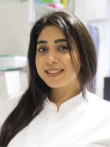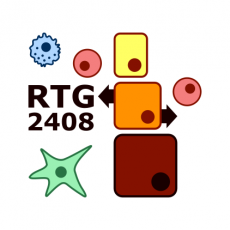Prof. Dr. Anne Dudeck

Prof. Dr. Anne Dudeck
Project Leader
Project 4
P4-1: Relevance of mast cells in maladaptation of the epidermal and endothelial barrier during chronic skin inflammation
Martin VossPhD Student
Anne DudeckProject Leader |
Contact allergy is an inflammatory skin disease of high socioeconomic relevance. We recently demonstrated an intimate interaction of dermal endothelial cells and mast-cells (MCs) in the skin. Importantly, MCs initiate the vascular response to haptens and neutrophil infiltration, and amplify the T cell-driven adaptive immunity. Surprisingly, we observed a massive MC hyperplasia several weeks after hapten-challenge, predisposing to chronified skin inflammation. Based on these observations we hypothesize that the perivascular MC hyperplasia provokes a disease-promoting micromilieu resulting in a permanent dysregulation of endothelial barriers. By combining longitudinal intravital imaging with cell biology approaches we aim to quantify parameters of vascular integrity, endothelial cell activation and luminal glycocalyx constitution. The interaction of the glycocalyx with the extracellular proteome will be analyzed (cooperation with Project 7). To assess the effect of perpetuated inflammation on entire skin vascularity, we will analyze the vessel structure and 3D architecture. To directly assess the causality of MCs for epidermal and vascular alterations in perpetuated skin inflammation we will utilize novel mouse models of constitutive or inducible MC-depletion. To characterize the disease-promoting micromilieu at the pathophysiological endothelial barrier we need to identify the cellular actuators and regulators beyond MCs and therefore aim to analyze the impact of endothelial cell activation and luminal glycocalyx on macrophage differentiation (cooperation with Project 6). The homeostasis of intercellular networks is tightly regulated by a number of tissue factors. We therefore aim to analyze alterations in the gene expression of transcription factors (cooperation with Project 9), cytokines and chemokines, complement and coagulation factors (cooperation with Project 5 and Project 6), hypoxia induced factors (cooperation with Project 2) and others, to identify key factors disrupting the endothelial barrier in the chronically inflamed skin as potential therapeutic targets. Maladaptive cell accumulation and intercellular communication lead to chronic skin inflammation. Acute hapten-induced skin inflammation (arrow) leads to an accumulation of mast cells (MC, violet) beneath the epidermal (yellow) barrier. Repeated hapten encounter in hapten-primed skin causes an exaggerated inflammation and neutrophil (green) infiltration potentially due to persistent MC degranulation that may culminate in structural and functional maladaptation of the endothelium (red) and epidermis. We hypothesize that the epidermal stress response (1) is causative for the accumulation of MCs which subsequently provoke endothelial activation (2) and neutrophil infiltration (3) via degranulation, cytokine/chemokine release and PAR2 activation. The exaggerated neutrophil influx vice versa results in persistent MC activation (4), perpetuated epidermal stress (5), and hypoxia (6) that finally culminate in endothelial dysfunction. |
Photos: by UMMD, Melitta Schubert/Sarah Kossmann
P4-2: Characterization of the specific functional relevance of perivascular mast cells in skin inflammation
|
|
As the outermost layer of an organism, the skin is highly exposed to noxious environmental influences. By sensitizing with allergens or haptens able to penetrate this physiological barrier, an immunological response can be induced. In Europe, more than 20% of the population is affected by allergic skin diseases, such as atopic dermatitis or allergic contact dermatitis. These inflammatory skin disorders are a main cause for occupational disability and thereby a massive burden for the patients and the health care system. Recently, we could demonstrate that directional release of active mediators including tumor necrosis factor (TNF) by perivascular mast cells (MCs) into the blood stream initiates a vascular response and neutrophil infiltration. Moreover, this process affects immune cells systemically in distant organs, such as spleen and bone marrow. We hypothesize that repeated MC activation can lead to chronic disorders by a dysregulation of the vasculature or long-term systemic effects on myeloid immune cell populations. Given the longevity of tissue-resident MCs, their heterogeneity in both distinct tissues and within the skin, as well as their plasticity during inflammation is poorly understood. We therefore aim to characterize perivascular skin MCs and to investigate their specific functional relevance in skin inflammation, in particular in the activation and integrity of the endothelial barrier (cooperation with Project 6). Further, we will study their organ-spanning acute and long-term effects (cooperation with Project 2, Project 8, Project 11, Project 12). Since MCs are known to interact with other cells along the blood vessels, such as dendritic cells or macrophages, our objective is further to study the perivascular immune cell niche. To address our topics, we will utilize novel mouse lines with specific knockouts of surface receptors that reduce the alignment and directional intravascular degranulation of perivascular MCs. We will use in vivo approaches such as intravital 2-photon fluorescence microscopy to analyze the intercellular network along the vascular system, and cross-validate our findings with in vitro cell communication assays (cooperation with Project 6). We aim to ascertain the mechanistic effects of MC degranulation on tissue homeostasis, gene expression of transcription factors, cytokines and chemokines and hypoxia induced factors (cooperation with Project 2, Project 6, Project 8 and Project 12). These studies will thereby assess the specific features and functional relevance of perivascular MCs in acute and chronic skin inflammation in order to identify novel therapeutic targets.
Mast cells in the perivascular immune cell niche have critical functions during skin inflammation. We hypothesize that within the perivascular immune cell niche, MCs exhibit a distinct phenotype compared to non-vessel attached interstitial MCs (1). Furthermore, these specialized characteristics promote the intercellular communication with adjacent cells of the perivascular immune cell niche (2). Eventually, perivascular MCs might be involved in the transmission of local inflammation into systemic effects due to the directional release of MCGs into the bloodstream, even beyond the induction of immune cell recruitment (3). [Created by BioRender.com] |
Photos: by UMMD, Melitta Schubert/Sarah Kossmann
P4-3: Bidirectional cross-talk between Mast Cells and Endothelial Cells in homeostasis and inflammation
|
|
Mast cells (MCs) are tissue-resident innate immune cells that have critical functions in host defense, and play pivotal roles in allergic and inflammatory responses. They are ubiquitously distributed throughout the body, with a particular enrichment in barrier tissues, such as the skin, lungs, and the intestinal mucosa. Upon activation via different receptors, MCs release granules that are filled with a plethora of fully active mediators such as histamine, cytokines like TNF, and proteases. Since this process, called degranulation, occurs within seconds after their activation, MCs have important sentinel functions in the initiation of immune responses and thus as the first line of defense. We previously reported that, in the skin, MCs are located in very close proximity to blood vessels, and are critical for the early onset of innate immunity by rapidly initiating vascular responses and the recruitment of innate and adaptive immune effector cells. We hypothesize that in acute inflammation, MCs affect endothelial cell (EC) programming and functions, which may subsequently lead to dysregulation of the vasculature or long-term systemic effects on myeloid immune cell populations. This project aims to investigate the interactions between MCs and ECs during inflammatory responses on a tissue-wide, cellular and molecular level. The primary objective of this project is to explore how MCs influence EC characteristics and behavior, including their activation, expression of adhesion molecules, and transcriptional responses, both locally (in the skin) and systemically (e.g. in the bone marrow). We will employ a multifaceted experimental approach to uncover the mechanisms of MC-EC communication. Single-cell RNA sequencing (scRNAseq) of perivascular MCs will be utilized to identify key transcription factors and functional mediators involved in MC-EC crosstalk (cooperation with project 12-2, 12-3). Advanced multiscale imaging techniques, such as intravital microscopy, Lightsheet microscopy and multiparameter microscopy will allow for studying MC adhesion and activation dynamics in vivo and its mechanisms (cooperation with project 4-2). Complementing these studies, in vitro co-culture models with both human and mouse ECs and MCs will be developed to investigate direct cell-cell interactions and the impact of MC degranulation on EC activation and vascular integrity (cooperation with project 13-3).
|
Photos: by UMMD, Melitta Schubert/Sarah Kossmann
MD2: The capacity of mast cells to translate skin inflammation into systemic effects
|
|
Allergic contact dermatitis is an inflammatory skin disease that comprises 20% of occupational skin disorders. The contact hypersensitivity (CHS) is the respective mouse model, in which small organic compounds (e.g. dinitrofluorobenzene (DNFB)) are used as haptens. The hapten encounter into the skin disrupts the epidermal barrier and induces a keratinocyte stress response including the release of alarmins, e.g. IL-33 and ATP. Mast cells (MCs) sense the cell stress signals and respond by immediate degranulation of preformed mediators, such as histamine, TNF, IL-6 and IL1-β. Thereby they cause a vascular response and initiate innate immunity including the influx of neutrophils. We could recently show that perivascular MCs can pass the vascular barrier and form granule-rich intraluminal sheets. Upon inflammatory insult, these perivascular MCs degranulate directionally into the blood vessels. That is why we hypothesize that MCs are able to translate the local inflammation into systemic effects that amplify the immune response. However, this process may lead to detrimental exuberant effects. We will analyze the impact of local skin MC degranulation on I) splenic and bone marrow cell subpopulations and the recruitment of lymphoid and myeloid cells using flow cytometric analysis, II) hematopoietic niches in bone marrow by analyzing the localization of bone marrow resident cell populations using multi-epitope-ligand cartography, and III) humoral immune components, e.g. acute phase proteins, cytokines and chemokines using multiplex serum analysis. In addition to MC activation by DNFB-induced CHS, we will confirm promising findings using mastoparan, a direct MC activator. To determine the role of MCs and of MC-derived IL-6 as well as TNF we will use MC-deficient mice and mouse lines with a MC-specific gene inactivation of IL-6 and TNF.
Systemic supply of TNF and IL-6 by intravascular degranulation of perivascular MCs. Epicutaneous application of DNFB leads to directional degranulation of perivascular MCs into dermal blood vessels. This induces an activation of circulating neutrophils facilitating their extravasation to the inflamed skin. We hypothesize that this MC capacity may lead to systemic effects on bone marrow, spleen and on the production of humoral components of the innate immune response. |
Photos: by UMMD, Melitta Schubert/Sarah Kossmann
MD4: Investigating the mode of mast cell-driven translation of local inflammation into systemic effects — impact mobilization or emergency myelopoiesis?
|
|
Mast cells (MCs) are long-lived immune cells that predominantly reside in tissues at interfaces with our environment. In particular, they function as sentinels, e.g. in the connective tissue of the skin and in the mucosae, and contribute to acute host defense. We found that in contact hypersensitivity (CHS), a mouse model of human allergic contact dermatitis, MCs sense the keratinocyte cell stress mediators ATP and Interleukin (IL-) 33. The resulting MC degranulation induces vascular responses and neutrophil recruitment. Importantly, perivascular MCs are able to cross the endothelial barrier, form intraluminal sheets and degranulate directionally into the bloodstream upon inflammatory insult. Tumor necrosis factor (TNF), contained in these granules, was found responsible for priming blood neutrophils. Consequently, we hypothesize that MCs can initiate systemic effects upon local inflammation, for example by releasing several proinflammatory cytokines and chemokines, such as TNF and IL-6 . To address this hypothesis, we will investigate the impact of MC depletion on I) the release of humoral components of innate immunity (acute phase proteins, cytokines, chemokines), II) immune cell mobilization from the bone marrow (BM), spleen, and thymus and III) the perivascular BM-resident dendritic cell (DC) subsets involved in progenitor mobilization. By comparing local and systemic MC depletion, we will discriminate the role of skin resident MCs from the functions of MCs in the target organ, e.g. spleen and BM. Moreover, by examining the kinetic of MC effects, we will clarify whether MCs predominantly induce cell mobilization from distant organs, or affect the subsequent restoration of the cell pool by emergency myelopoiesis.
The contact hypersensitivity model and intravascular degranulation of perivascular MCs. Epicutaneous application of DNFB triggers keratinocyte cell stress and release of ATP and IL-33. MCs respond by degranulation, thereby inducing vascular responses and neutrophil recruitment. Mechanistically, we found that perivascular MC degranulate directionally into the bloodstream, which, beyond neutrophil recruitment, may cause systemic effects. |
Photos: by UMMD, Melitta Schubert/Sarah Kossmann
MD12: Investigating the role of mast cells in central and peripheral trained immunity upon skin inflammation
|
|
Traditionally, it is believed that only the adaptive immune system exerts mechanisms of immune memory, which help respond to following infections with the same pathogen in an adapted and faster way. However, research of the last decade has shown, that the innate arm of immunity can adapt the response to infections as well – a concept that has been termed “trained immunity”. It is a process involving long-term epigenetic, transcriptomic, and metabolic adaptations in innate immune cells (i.e. peripheral trained immunity) or their progenitors (i.e. central trained immunity) to enhance subsequent immunity. However, the same mechanisms can also underlie maladaptive changes contributing to the progression of acute to chronic inflammation. Specifically, I will focus on allergic contact dermatitis (ACD), an inflammatory skin disease with a high socioeconomic burden. In ACD, hapten-induced stress responses in the epidermal barrier cause mast cell (MC) activation and degranulation, which in turn drive inflammation and itching, and thereby the vicious cycle towards chronic inflammation. We hypothesize that MCs play a crucial role in the induction of trained immunity. Therefore, we want to determine the relevance of MCs in central trained immunity in response to hapten, to investigate MC-driven effects on peripheral trained immunity, and to conduct mechanistic studies on the specific roles of MC-derived TNF and IL-6 in trained immunity. By elucidating the impact of skin MCs on trained immunity, this study contributes to the identification of novel targets for therapeutic intervention in skin diseases. Furthermore, it enhances our understanding of the development of these diseases, advancing the field towards more precise and effective therapeutic strategies.
(Created with biorender.com) |
Photos: by UMMD, Melitta Schubert/Sarah Kossmann
AP7: The role of Syndecan-4 in the development of Osteoarthritis
|
|
Osteoarthritis (OA) is a widespread disease that plays a particularly important role in the increasingly aging population. According to the WHO, OA is one of the top 10 most disabling diseases in the developed countries. In 2019, total hip or knee arthroplasty implantation was one of the most common full hospitalization surgeries in Germany, accounting for approximately 450,000 cases. Syndecan-4 (Sdc4) is a transmembrane protein and belongs to the heparan sulfate proteoglycan family. Interestingly, Sdc4 expression in different cell types is upregulated by pro-inflammatory cytokines in a NF-κB-dependent manner. Moreover, Sdc4 itself is actively involved in the regulation of IL-1 signaling, as the absence of Sdc4 in fibroblasts results in decreased IL-1 signaling. Loss of Sdc4 or blockage of Sdc4-dependent signaling protects mice from OA and rheumatoid arthritis (RA)-induced joint destruction. Moreover, the extracellular domain of Sdc4 can be proteolytically cleaved off at the cell membrane surface, releasing the still intact ectodomain into the extracellular matrix. We were able to detect the soluble form of Sdc4 in the synovial fluid of knee OA patients. Therefore, this projects aims to investigate whether the shedding process is disease dependently regulated and which cells of the knee joint (e.g. chondrocytes, synoviocytes) contribute to process of Sdc4 shedding. Since good biomarkers for the degradation and regeneration of the cartilage as well as a good read out for the efficacy of novel therapeutics for OA are still missing, this project also examines the potential of shed Sdc4 in synovial fluid as a marker for OA severity. Further, during this project the shedding mechanism during OA progression shall be elucidated. Especially, it is of interest which proteases are responsible for the shedding in OA and how these are regulated in the context of the disease. On a functional level, this project also aims to establish the role of Sdc4 shedding in OA. Since the absence of Sdc4 proved to decrease the efficiency of IL-1 receptor recycling, the influence of induced Sdc4 shedding on IL-1 signaling is another main aspect of this project. Overall this project will help to unravel the function of Sdc4 in OA and thereby lead to a better understanding of the development and progression of this disease. (This project was externally supervised by Prof. Dr. Jessica Bertrand)
Syndecan-4 shedding in osteoarthritis. |
Photos: by UMMD, Melitta Schubert/Sarah Kossmann



























